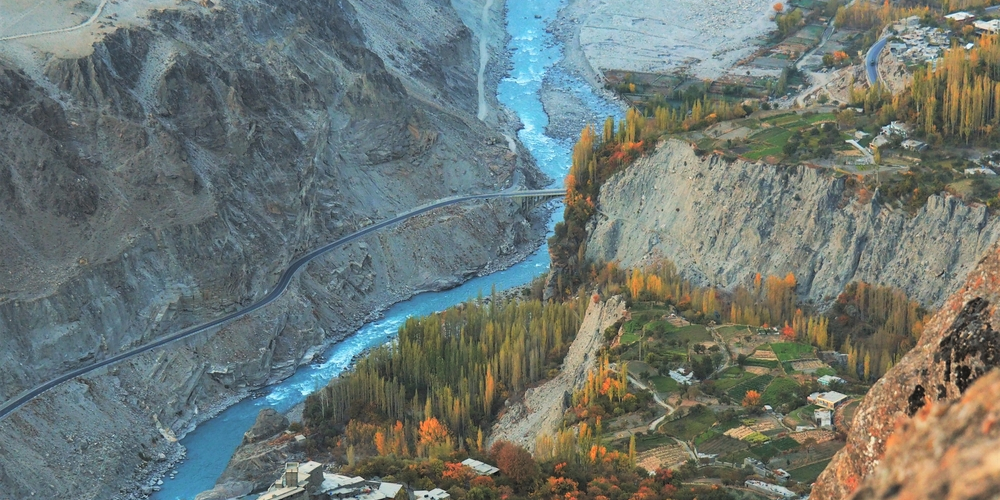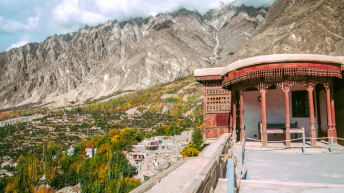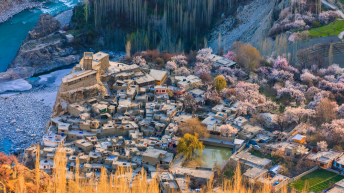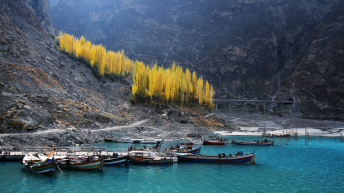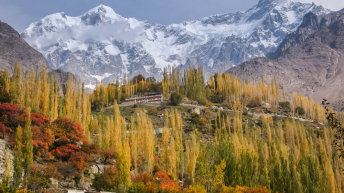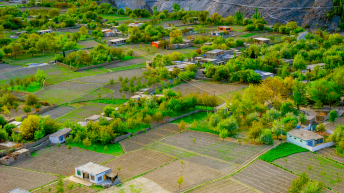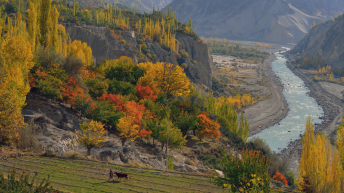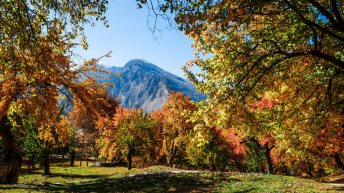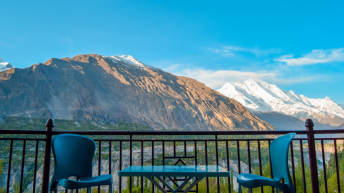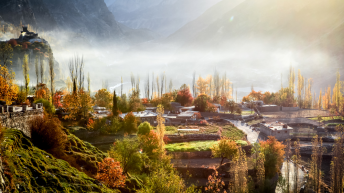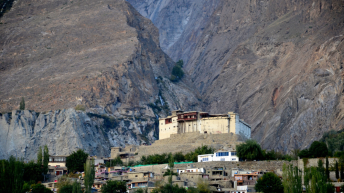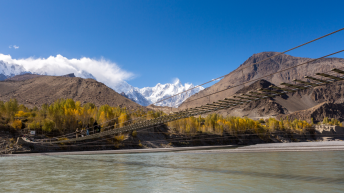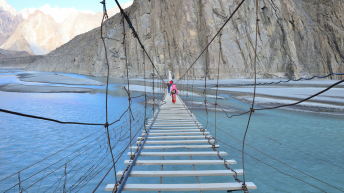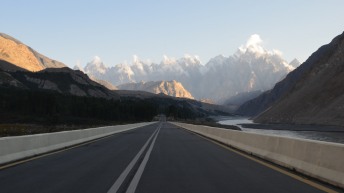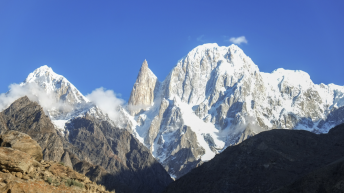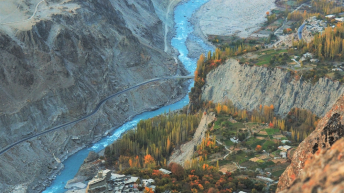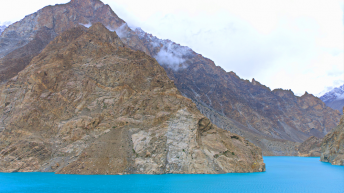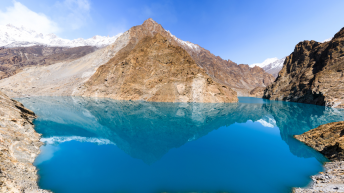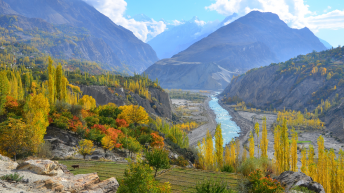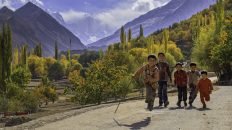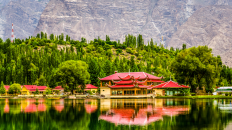Hunza valley is probably Pakistan’s most visited valley, by the tourists. It is a fairy tale land surrounded by beautiful rugged & snow-capped mountains. Only at a distance of 100 Kms. from Gilgit, Hunza is a small town on Karakorum Highway. At the altitude of 7000 – 800 feet it is the first main town or stops if you are entering Pakistan from China. Hunza valley has beautiful lakes, high mountains, and white glaciers.it provides a beautiful scene that entertains tourists. The view of Hunza valley in autumn season is very nice and in winter the sheet of white snow covers the whole valley.
Hunza valley contains around four huge lakes but one of them is very famous around the world is ATTABAD LAKE.
In Jan 2010 a massive landslide created a giant lake by blocking the narrow Hunza valley with its river around Attabad. Attabad lake is about 20km in length and up to 100m (300ft) in depth, With the creation of this lake, more than 18 kilometers of the Karakoram Highway has been submerged, lost somewhere in the depths, suspending transportation by road. the only option is to cross the lake, reach the Hussaini Village, and get on the Karakoram Highway again.
But Now the Lake has developed again and used as a tourist spot. The lake is used for boating, water sports, and fishing.
Altit Fort
The Altit Fort is the oldest Fort in northern areas which is located at the bottom of the Hunza valley. Altit Fort was constructed under the king of Hunza who is famous as Mir.
It has own historical value. it considered to be the birthplace and capital of Hunza city. it was built in the 11th century and also it is the wonder of the art of ancient people and the technology of that time. not only has it survived many attacks from aggressors but also withstood several earthquakes since it was built, perhaps making it one of the most astonishing architectural structures of its time.
In its earlier days, the fort was surrounded by the settlers of the city and traders who would bring along goods from across the world making their way to the land from China through the ancient Silk route, and soon it became a cultural hub of the region. But since 1990 the fort is under the Aga Khan Foundation and operating as a tourist museum.
Baltit Fort
About 700 years old historical building of Baltit Fort is located on the top of karimabad of Hunza valley. in the ancient time, the Baltit Fort is used to be the seat of governance for the ‘mirs’ time. the royal family used to live altit fort before moving to Baltit Fort they ruled over 1000s of years in the surrounding areas.
Its unique structure is destroyed by the Maharaja of Kashmir and many other rulers on the war attack but, Later the Aga Khan development foundation rebuilt it to its original looks.
Today it stands as a symbol of the region’s history and is one of the major tourist attractions in the Gilgit-Baltistan region.
Karimabad
Karimabad is the capital of Hunza Valley, Baltit is the old name of Karimabad. It is named after Prince Karim Aga Khan, the spiritual head of Shia Ismaili Nizari community. People still refer to Karimabad as Baltit. The Guardian ranked it as one of the five Best Tourist Sites in Pakistan Both Baltit Fort and Karimabad village received the World Award of Tourism in 2000 when Indonesia, Australia, India and Britain and other countries competed.
Ali Abad
Aliabad (Burushaski) is the administrative and commercial center of the Hunza District of Gilgit Baltistan, formerly in the State of Hunza.
Fruits of Hunza valley
Hunza people developed their agriculture system and has grown the best crop. while the Hunza fruits are very delicious and unique.
There are many kinds of fruits cultivated, eg. apricots, cherry, nectarine, peach, apple, plum berry, grapes, pear etc. When we talk about the Hunza fruits we can not forget about Hunza apricots. Apricot trees are more common in Hunza valley, which is famous legend fruit of the valley and in ancient time was the main source of the food. hunza people used apricots juice as diet they dried them in summer and used them in winter season That’s why they never had cancer or low cancer rate. while the other stone fruits are also significant crops in these areas.
Glaciers
Hunza valley has got the natural beauty of glacier that is very high on the mountain. Tourist visits these glaciers for enjoyment and to be near to the beauty of nature. God blessed the Hunza valley with a beautiful glacier which includes:
Hisper Glacier :
Hisper Glacier is Located in Nagar Valley. But the viewpoint of that Glacier is Hunza valley. If you want to make the trip wonderful then Visit Hisper valley to see the Glacier. This glacier is one of the main attractions of tourism.
Biafo Glacier
Biafo Glacier is Also Located in Hopar Nagar Valley. This Valley is near to Hunza. Tourist can visit this amazing glacier. It’ll take a few hours to reach this location.
Passu Glacier
Passu Glacier is located on the south side of “Passu village” is also known as the home of Glaciers. This glacier is linked with Batura Glacier and many other glaciers in these regions. The Glacier is visible and can be seen on the way towards khunjerab pass. After Ghulk In the village. An excellent scenery and also a good place to take some rest while heading towards the end line of your journey. The glaciers are easy to access with your private card, you can plan the trip even if you have a short time to see the glacier and enjoy some moments of the cold breeze.
Batura Glacier
Batura Glacier is also located in the beautiful village passu. its length is about 57km and spread over 285 sq km, Batura is 5th longest Glacier outside the polar regions. its tail end with 8th wonder of the world “KKH”. Its average height is 3800m. On the Glacier wild alpine flowers filled meadows, birch trees and where roses and juniper trees are common.
LadyFinger peak
Ladyfinger Peak is a distinctive rock spire in the Batura Muztagh, the westernmost sub-range of the Karakoram Range in Pakistan. It lies on the southwest ridge of the Ultar Sar massif, the most southeasterly of the major groups of the Batura Muztagh. The whole massif rises precipitously above the Hunza Valley to the southeast. Bublimotin, while having little prominence above the saddle with nearby Hunza Peak, is particularly notable for being a sharp, relatively snowless rock spire among snow peaks. This, combined with its height above the valley, makes it quite eye-catching; hence the distinctive name. It provides a 600 m rock climb and has been the scene of some notable paragliding.
Diran peak
Diran is situated between Rakaposhi & Haramosh massif of Karakoram Range, one of the most beautiful mountains with an easy climb of its snow dome. its Altitude is about 7273m. This peak has a fame for its dangerous snowstorms and avalanches. Lying with the Rakaposhi and Haramosh high peaks which beset by Minapin Barpu Boulter glacier, it increases a scenic view of the Hunza valley.
Diran was first ascended in 1968 by three Austrians Rainer Goeschl, Rudolph Pischinger, and Hanns Schell. Initial trials by a German team in 1959 and an Australian expedition in 1964 remained stuck.
Wildlife
Hunza Valley provides an excellent habitat for wildlife in the form of alpine grazing lands, sub-alpine scrub and temperate forests. These habitats support a variety of wild animals. The areas are difficult for human beings to access, hence, most wildlife is present in reasonable numbers though some are endangered.
Marco Polo sheep
The Marco Polo sheep is a subspecies of sheep, named after the visit of Marco Polo . Their habitat is the mountainous regions of central Asia. Marco Polo sheep are distinguishable mostly by their large size and spiraling horns. and keep them from commercial hunting. It has also been suggested that crossing them with domestic sheep could have agricultural benefits.
Tunnels on CPEC Route/Karakorum highway
The seven-kilometer long five tunnels are part of the 24 KM long portion of the Karakorum Highway which was damaged in 2010 due to land sliding at Attabad. These tunnels constructed by Pakistan and China government for the easy transport of goods from China to Gwadar. These tunnels are the sign of friendship of Pakistan. Before these tunnels there was no sign of road and goods were transport through boats in Attabad lake.

